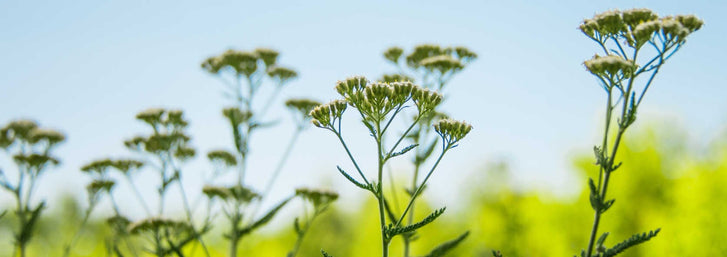
David Bernal

Over the past 40 years, True Leaf Market has had the privilege of sharing some very special heirloom and non-GMO varieties with you from all over the world. Many of these cultivars were grown and developed by the most passionate growers, breeders, and researchers throughout the centuries. We would like to take a moment to highlight an extraordinary individual who has made unparalleled contributions to our understanding of oilseed Brassica cover crops, foraging crops, and sustainable mustard biodiesels.
For more than 30 years, the University of Idaho’s Dr. Jack Brown has been the preeminent grower and researcher of the benefits of oilseed mustards (Brassicaceae), including rapeseed grown for canola oil. His tenure at the University of Idaho has led him to develop a number of well-researched and patented crops, most notably the Mighty Mustard® line, which provides a natural and organic means of insecticide, weed suppression while enriching soils with a nitrogen-rich biomass (“green manure”).

Born in Edinburgh and receiving his advanced degrees there in Scotland from the University of St. Andrews, Dr. Brown made his new home in Moscow, Idaho where he joined the faculty at the University of Idaho’s College of Agriculture and Life Sciences in 1992. During his time in the Pacific Northwest, Dr. Brown experienced the threats of monoculture posed by the always successful cultivation of cereal grains such as Hard Red winter wheat and Hard Red spring wheat. In his opinion, because wheat is the absolute easiest crop to grow on Earth, growers are always tempted by the cash crop which can increase the risk of local soil-borne diseases and pests. However, through decades of tireless research and trials, Dr. Jack Brown has been able to prove to many of these commercial wheat farmers the benefits and profits of rotational cropping with oilseed Brassicas such as Mighty Mustard®.
Indian mustards such as his Pacific Gold Mighty Mustard® and Kodiak Mighty Mustard® have been repeatedly tested to be first-rate natural pesticides, killing off more nematodes and roundworms than any of its competitors. While these two mustard varieties are proven insect repellents, White Gold Mighty Mustard® is a tenacious broadleaf weed suppressant best sown during the growing season as a companion plant. Trifecta Power Blend™ Mighty Mustard® features a patented blend of all three of these mustards specifically designed by the University of Idaho to create the most abundant and disease- and insect-free season possible.
Aside from being a premier cover crop, Dr. Jack Brown has also discovered that oilseed Brassicas such as mustard and rapeseed, are ideal foraging crops for livestock. During growing trials up in Moscow, ID, he soon noticed herds of local elk grazing on his Brassicas while leaving the wheat crop entirely untouched. Since then, he has argued that a high protein/low fiber crop such as mustard or rapeseed lends to the best animal fodder if blended with a low protein/high fiber cereal grain such as triticale.
Not to mention his dedicated study into the sustainability of Brassica-based biodiesels, Dr. Brown has only begun to imagine what is possible with the ancient mustard seed. Just three months ago this past May, Dr. Jack Brown finally retired from his 28-year position at the University of Idaho and we here at True Leaf Market, along with countless farmers, growers, and hobbyists would just like to say, thank you Jack!
Leave a comment
Your email address will not be published. Required fields are marked *
7 comments
BOnnie
How do these cover crops work in small backyard gardens. My experience with mustard is that it can be invasive or is that just wild mustard?
Herbert Dannenberg
I also would like to know the answer to the above question. Thanks.
Jennifer
What would be the best combination of grain and mustard to grow as an microgreen animal feed? What of your seeds would you re ommend that I purchase.
winnie taney
I also like to know the best cover crop for my raised beds. My problems: pests and weeds. thank you!
David Bernal
Hi there friends! Thanks for your questions regarding Mighty Mustard as used in smaller gardening. Bonnie, you are absolutely correct about it being an invasive crop if not maintained in smaller home gardens. In fact, there many vegetable and ornamental seeds sold that are classified as Invasive by the USDA such as periwinkle, cress, wisteria, and Forget-Me-Not to name a few. However, in regards with mustard grown as a seasonal cover crop, cover crops are always advised to be mowed down before the crop goes to seed (roughly at about 50% bloom). With Mighty Mustard specifically, the crop is ready to be mowed in roughly 35-40 days, plenty of time before the threat of reseeding. This can be difficult for some growers since it goes against instinct to chop down a crop before the blooms are even appreciated. But cover crops are grown specifically to replenish and fortify soils, not necessarily for visual splendor. Hope this helps!
David Bernal
Jennifer, If feeding large-scale livestock, I would have to take Dr. Jack Brown’s recommendation for creating a balanced high protein and high fiber diet of 50/50 Triticale and Mustard. However, as you specifically mentioned microgreens, are the animals you are looking to feed small, perhaps household pets? If so, various cereal grains and grasses like triticale, rye, wheat, and barley are all similar microgreens popularly included in our Pet Grass Kits, proven to be a healthy snacking option for cats and dogs in tandem with mustard, broccoli, and chia microgreens. And microgreens, especially mustard, change flavor as they mature into a mature plant. I’ve noticed personally with my dog that she knows immediately whether she likes the taste of a particular microgreens variety or not. But the joy of microgreens as opposed to mature plants is that they’re brimming with nutrients and vitamins, so there is no bad combination.
David Bernal
Winnie, I would suggest doing the same thing to your raised beds as my wife and I will do with ours in a few weeks. We will be sowing our raised beds with the Garden Cover Crop Seed Mix, which is a blend of 9 different varieties of cover crops including both yellow mustard and triticale. The benefit of this 9-variety mixture is that it features a crop to take care of just about anything in your soil. The mix features multiple crops with deep taproots and fibrous roots to loosen soils, improve tilth and drainage, while also suppressing weed development. Many are allelopathic, meaning they emit chemicals that slow and repel the germination of immediately competing seeds (weeds). If new to fall cover crop gardening, I would definitely recommend trying our cover crop mixture so you may experience the whole spectrum of benefits in next season’s soil.
Further Reading

10 Natives of the Southwest USA for Pest Control
Written By Lara Wadsworth The Southwestern United States is a region incredibly unique to the rest of the country. The hot, dry weather can be challenging for plants and animals to thrive without additional help. That is why gardening with natives can ...

Ashleigh Smith
2024-04-157 min read0
Spring Into Action - Celebrating Earth Day
Written By Chelsea Hafer Spring is quickly arriving, and that means that Earth Day is near! Earth Day is the perfect occasion to appreciate our wonderful planet and all that it does for us and think of ways you can give back to it. In this blog post, w...

Ashleigh Smith
2024-04-154 min read0
Everything You Need To Know About Rain Gardens
Written By Lara Wadsworth Rain gardens are quickly gaining popularity for their perfect marriage of utility and beauty. What simply looks like a beautifully landscaped garden is actually a native habitat that serves as a storm drain and water sponge. B...

Ashleigh Smith
2024-04-085 min read1
Northeastern Natives for Attracting Beneficial Insects
Written By Lara Wadsworth The Northeastern United States is rich with American history, but did you also know that it is rich in plant biodiversity? Nature has learned through time how to work in harmony with the various species that attempt to thrive....

Ashleigh Smith
2024-04-086 min read1



